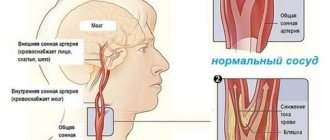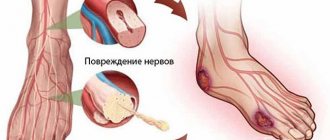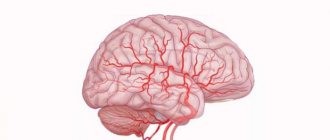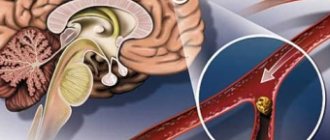Blood circulation can be disrupted anywhere in the human body. Blood circulating through arterial vessels may encounter an obstacle on its way in every organ if the walls of the arteries and arterioles have changed as a result of pathological processes. Ischemia can occur in the intestines, kidneys, and spinal cord. Although the latter tolerates heart attacks and hemorrhages better than the brain, a spinal stroke can put a person in a wheelchair for a long time, if not forever, immobilizing him, and lead to complete or partial loss of ability to work.
In the path of arterial blood moving under pressure, there may be an aneurysm that withstood a long load, and then ruptured... Severe hemorrhage, often giving no chance of life. An aneurysm can find a place and form in any arterial vessel.
In varicose veins, behind the blood carrying metabolic products, the venous valves may simply not close, preventing reverse flow. In this case, the blood can only return back to stagnate in the organs and limbs.
Varicose veins are characteristic not only of the vessels of the lower extremities; all pelvic organs, the spinal cord, and upper extremities are well susceptible to it (although they are located above the heart). There are “purely female” varicose veins, when the pathology affects the venous vessels of the reproductive organs (uterus, vagina, ovaries, etc.), and there are also “purely male” ones - varicocele, for example. And there are those that equally cause trouble for both the male and female populations of the planet. Varicose veins of the rectum, or simply hemorrhoids, have plagued our sedentary generation from a young age.
Disruption of the venous valves, dilation of veins, and the formation of blood clots leads to venous insufficiency (VI), which is very dangerous due to its complications. Chronic VL, characteristic of superficial veins, represents good conditions for the development of thrombophlebitis and trophic ulcers. An acute form of venous insufficiency can create a life-threatening situation when it is complicated by deep vein thrombosis, which, in turn, will result in post-thrombotic syndrome. And it all started with venous insufficiency...
A complication of acute venous thrombosis of deep and superficial veins is pulmonary embolism - the culprit of high mortality, which in its symptoms is even ahead of venous thrombosis, that is, thrombosis is the cause, but has not yet manifested itself, and PE has already taken the initiative. Any operation, injury or childbirth can be complicated by pulmonary embolism and lead to death, since the fulminant form ends in death within 10 minutes, the acute form - within 24 hours, and only the subacute form gives a person a certain chance, developing gradually and manifesting itself as a pulmonary infarction.
What are blood vessels?
Vessels in the body play a key role, which is determined by the transport of various substances. They carry oxygen and carbon dioxide, beneficial elements from food, white blood cells, platelets, and so on. The vascular network is located throughout the body, both in the abdominal cavity and in the head and limbs.
Arteries perform the function of transporting beneficial substances, so they suffer much less than veins, which are forced to transport harmful substances, and in an upward direction, against gravity . The exception to this is the blood vessels of the lungs, in which arteries transport carbon dioxide, and veins, on the contrary, transport oxygen.
As you move away from the center, the size of the veins and arteries decreases and capillaries approach the cells directly . Capillaries have a special structure; they pass through their walls useful elements and products that must be removed from the human body.
In the kidneys they form a glomerular system, thanks to which all harmful substances enter the urinary system. It is the peripheral vessels that suffer first, disrupting the supply of tissues with useful substances, provoking their death.
How does the human cardiovascular system work?
The vascular system includes two circles of blood circulation - large and small. In a large circle, arterial blood from the left ventricle of the heart travels through the aorta, and then through large and small arteries to all organs and tissues. Arterial blood carries with it nutrients and oxygen necessary for cellular metabolism.
Nourishing the tissues, small arteries turn into capillaries and then into veins. Veins drain venous blood from organs and tissues, containing metabolic products and carbon dioxide. Venous blood collects in increasingly larger veins, through which blood enters the right atrium.
What do the symptoms depend on?
Signs and symptoms of vascular disease can be completely different and depend on their location. There are two main types of pathologies: diseases of the central vessels and peripheral ones. In addition, how the disease manifests itself also depends on the specific pathology of the vessel, for example, a violation of the structure of its wall, blockade by nerve fibers, obstruction due to a blood clot or atherosclerotic plaques, spasm, and so on.
Vascular pathologies develop very quickly, but often remain asymptomatic and do not make themselves felt for a long time. The main signs of vascular diseases include:
- Cough . This cough has characteristic symptoms: it is dry, often manifests itself in a lying position, and expectorants do not help with it.
- Weakness and pallor . Diseases can manifest as functional disorders of the nervous system, for example, absent-mindedness or tremor.
- Hyperthermia . The temperature rises if the vascular pathology was caused by an inflammatory disease.
- Pressure . The main sign that all is not well with the blood vessels is an increase in pressure, which is repeated regularly against the background of pulse disturbances.
- Edema . This symptom can be caused by many pathologies, vascular being only one of them.
- Shortness of breath . A symptom that often implies angina.
- Nausea and vomiting . Based on the signs of vascular pathology, it can often be confused with gastritis.
- Pain as with osteochondrosis , for example, in the left hand, wrist, and so on.
- Chest pain . Accompanied by a feeling of burning, squeezing, it can be dull or sharp, constant or periodic, and so on.
Medicines
In the treatment of vascular diseases, drugs are used that improve blood circulation, increase the lumen in damaged capillaries, and cleanse blood vessels of plaques. With the help of the right choice of medications, it will be possible to normalize metabolism and get rid of oxygen starvation in the tissues.
People at risk require constant intake of ascorbic acid, vitamin E, and fish oil.
Causes of pathologies
The main causes of vascular pathology are:
- inflammatory diseases;
- developmental defects;
- atherosclerotic plaques;
- diseases that cause deterioration in the strength of blood vessels;
- autoimmune and allergic pathologies;
- embolism and thrombosis;
- change in vascular tone.
In addition, among the causes of vascular pathologies are:
- blood diseases;
- cardiac dysfunction after chronic infection;
- diabetes;
- high cholesterol;
- CNS disorders;
- avitaminosis.
Cerebrovascular disorders
When the arteries of the brain are damaged by atherosclerosis, a gradual increasing decline in mental abilities (encephalopathy) may develop. Symptoms of encephalopathy: memory deterioration, the ability to assimilate new knowledge and skills, a decrease in critical attitude towards one’s condition.
At the same time, with sharp spasms of the blood vessels of the head, the development of transient cerebrovascular accidents and ischemic strokes associated with the death of brain tissue due to disruption of its nutrition is possible. And since the brain is the main regulator of the activity of all organs and systems of the body, the symptoms of a stroke are manifested by the loss of those functions that were regulated by the affected area of the brain - individual movements, speech, vision, hearing, etc.
Cerebral circulation disorders can also be associated with the condition of the spine. So, with cervical osteochondrosis (metabolic-dystrophic disease of the spine), the arteries supplying the brain in the neck are compressed, at the place where they pass through the hole in the spine. This manifests itself in the form of attacks of dizziness and fainting.
Major diseases of the central arteries and veins
The great vessels play an important role as they supply blood to the main organs. Atherosclerosis is primarily responsible for the development of such pathologies. Subsequently, the accumulation of plaques, the vessels narrow, and there is a tendency to form blood clots and tissue damage. Diseases of the main vessels include the following.
Ischemic heart disease . This is a disease that develops when there is insufficient oxygen supply to the heart muscle due to poor patency of the coronary arteries. Very often the disease manifests itself asymptomatically, other forms are:
- angina pectoris, which is manifested by pain behind the sternum, radiating to the neck and left arm;
- arrhythmic form, manifested by shortness of breath, increased heart rate and interruptions in heart function;
- myocardial infarction, the symptoms resemble angina pectoris, however, it is not relieved by the usual means.
Cerebral vascular ischemia . A disease manifested as a result of decreased blood flow caused by cerebral atherosclerosis. Symptoms of vascular disease are as follows:
- memory impairment;
- mood swings;
- headache, dizziness;
- loss of consciousness;
- nausea and vomiting;
- numbness of the limbs;
- feeling cold;
- general sweetness;
- dysfunction of the nervous system and others.
Cerebral ischemia of the 1st degree is called compensated, its changes are reversible. It manifests itself as weakness, insomnia, personality disorders, depression, and tinnitus. In the second degree, the disease worsens. The signs of the first degree are repeated, but more pronounced, and symptoms of clogged blood vessels are added.
With 3 degrees of ischemia, the following appear: impaired swallowing, Parkinson's syndrome, fainting, mental disorders in the form of dementia. At this stage, the consequences are irreversible, and mental disorders worsen to the point of complete degradation.
Cardiopsychoneurosis . In the disease, peripheral arteries are affected due to a failure of the governing part of the central nervous system. Manifested by dizziness, headaches, fainting, nausea and diarrhea. This is a mild form of the disease and affects about 80% of the city's residents.
Constriction of cerebral vessels: who is at risk and how to recognize it
Illness We often experience headaches and noises, which can be aggravated by dizziness.
Moreover, severe pain leads to memory impairment. We can't remember where we put the items or forgot about the upcoming meeting. In this case, we tend to attribute everything to overwork. But the reason may be completely different. Severe headaches indicate a narrowing of the blood vessels in the brain, or, more simply, atherosclerosis.
The cause of vasoconstriction is the occurrence of cholesterol plaques in the arteries that supply our brain. The walls of the arteries become hard, clogged with cholesterol, and blood stops passing through them. as a result, brain nutrition deteriorates, which leads to memory impairment and headaches.
Plaques, in turn, lead to increased blood clotting and a blood clot begins to form. In this condition, complete closure of the arteries by a blood clot leads to a stroke.
Therefore, even with the slightest suspicion of atherosclerosis, it is important to promptly check cholesterol levels and, if necessary, reduce them.
Major peripheral vascular diseases
What are the types of vascular diseases of the extremities? Such diseases include: arthritis of the lower extremities, atherosclerosis of the arteries of the legs, varicose veins and thrombophlebitis.
Most often, arthritis is transmitted genetically and manifests itself as a result of impaired immune processes, affecting men more. Accompanied by acute pain in the calf area, cramps, increased pain when walking, as well as trophic changes on the surface of the skin.
Varicose veins begin with the vascular network and are characterized by swelling, pain, and protruding veins. If the deep veins are affected, the symptoms become more pronounced . There is a special form of varicose veins - hemorrhoids; it can be accompanied by pain, bleeding, itching and most often requires surgical intervention.
Diagnostic principles
It is important to note that the diagnostic plan for each patient with vascular pathology will be individual. The doctor determines the necessary examination methods based on the patient’s complaints, medical history and clinical manifestations of the disease.
Standard instructions imply the following:
- Laboratory tests:
- clinical blood and urine tests;
- biochemical blood test;
- lipid profiles;
- blood clotting test;
- determination of markers of cardiomyocyte damage (troponin, AST, etc.).
- Instrumental tests:
- electrocardiography;
- plain radiography of internal organs;
- angiography;
- Dopplerography;
- modern methods of visual diagnostics - CT, MRI.
Disease Prevention
In order to reduce the likelihood of developing diseases, it is necessary to maintain the tone of the vascular walls. To do this, you need to eat specially, giving preference to vegetables and fruits. Eating fatty and fried foods is prohibited . It is recommended to eat fish and dairy products with low fat content.
Attention! In no case should you smoke or drink alcohol if you have a history of vascular diseases in the family.
You also need to move a lot, it is advisable to do simple gymnastics every day. Walk, swim and do Pilates a lot.












